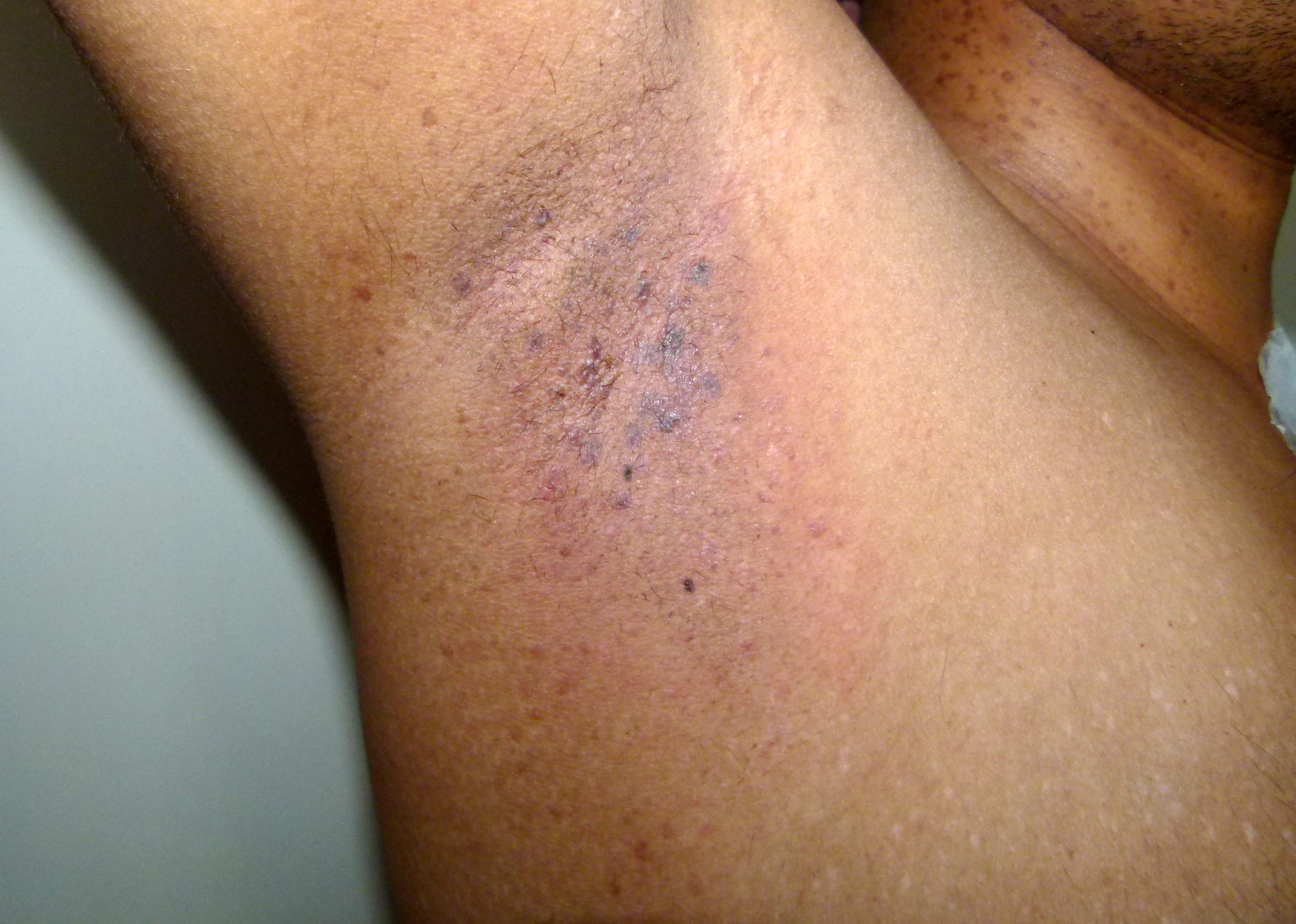[1]
Mahajan SH, Mahajan SA, Khopkar US, Kharkar VD. Follicular Dowling-Degos Disease: A Rare Pigmentary Dermatosis. Indian dermatology online journal. 2017 Nov-Dec:8(6):487-489. doi: 10.4103/idoj.IDOJ_311_16. Epub
[PubMed PMID: 29204397]
[2]
Betz RC, Planko L, Eigelshoven S, Hanneken S, Pasternack SM, Bussow H, Van Den Bogaert K, Wenzel J, Braun-Falco M, Rutten A, Rogers MA, Ruzicka T, Nöthen MM, Magin TM, Kruse R. Loss-of-function mutations in the keratin 5 gene lead to Dowling-Degos disease. American journal of human genetics. 2006 Mar:78(3):510-9
[PubMed PMID: 16465624]
[3]
Basmanav FB, Oprisoreanu AM, Pasternack SM, Thiele H, Fritz G, Wenzel J, Größer L, Wehner M, Wolf S, Fagerberg C, Bygum A, Altmüller J, Rütten A, Parmentier L, El Shabrawi-Caelen L, Hafner C, Nürnberg P, Kruse R, Schoch S, Hanneken S, Betz RC. Mutations in POGLUT1, encoding protein O-glucosyltransferase 1, cause autosomal-dominant Dowling-Degos disease. American journal of human genetics. 2014 Jan 2:94(1):135-43. doi: 10.1016/j.ajhg.2013.12.003. Epub
[PubMed PMID: 24387993]
[4]
Ralser DJ, Basmanav FB, Tafazzoli A, Wititsuwannakul J, Delker S, Danda S, Thiele H, Wolf S, Busch M, Pulimood SA, Altmüller J, Nürnberg P, Lacombe D, Hillen U, Wenzel J, Frank J, Odermatt B, Betz RC. Mutations in γ-secretase subunit-encoding PSENEN underlie Dowling-Degos disease associated with acne inversa. The Journal of clinical investigation. 2017 Apr 3:127(4):1485-1490. doi: 10.1172/JCI90667. Epub 2017 Mar 13
[PubMed PMID: 28287404]
[5]
Kim YC, Davis MD, Schanbacher CF, Su WP. Dowling-Degos disease (reticulate pigmented anomaly of the flexures): a clinical and histopathologic study of 6 cases. Journal of the American Academy of Dermatology. 1999 Mar:40(3):462-7
[PubMed PMID: 10071319]
Level 3 (low-level) evidence
[6]
Hanneken S, Rütten A, Pasternack SM, Eigelshoven S, El Shabrawi-Caelen L, Wenzel J, Braun-Falco M, Ruzicka T, Nöthen MM, Kruse R, Betz RC. Systematic mutation screening of KRT5 supports the hypothesis that Galli-Galli disease is a variant of Dowling-Degos disease. The British journal of dermatology. 2010 Jul:163(1):197-200. doi: 10.1111/j.1365-2133.2010.09741.x. Epub 2010 Mar 5
[PubMed PMID: 20222933]
Level 1 (high-level) evidence
[7]
Pickup TL, Mutasim DF. Dowling-Degos disease presenting as hypopigmented macules. Journal of the American Academy of Dermatology. 2011 Jun:64(6):1224-5. doi: 10.1016/j.jaad.2009.11.015. Epub
[PubMed PMID: 21571208]
[8]
Yun JH, Kim JH, Choi JS, Roh JY, Lee JR. Treatment of Dowling-Degos disease with fractional Er:YAG laser. Journal of cosmetic and laser therapy : official publication of the European Society for Laser Dermatology. 2013 Dec:15(6):336-9. doi: 10.3109/14764172.2013.764437. Epub 2013 Mar 6
[PubMed PMID: 23464495]
[9]
Wenzel J, Tappe K, Gerdsen R, Uerlich M, Philipp-Dormston W, Bieber T, Petrow W. Successful treatment of Dowling-Degos disease with Er:YAG laser. Dermatologic surgery : official publication for American Society for Dermatologic Surgery [et al.]. 2002 Aug:28(8):748-50
[PubMed PMID: 12174072]
[10]
Wenzel G, Petrow W, Tappe K, Gerdsen R, Uerlich WP, Bieber T. Treatment of Dowling-Degos disease with Er:YAG-laser: results after 2.5 years. Dermatologic surgery : official publication for American Society for Dermatologic Surgery [et al.]. 2003 Nov:29(11):1161-2
[PubMed PMID: 14641349]
[11]
Alshaikh H, Alsaif F, Aldukhi S. Clinical and Genetic Review of Hereditary Acral Reticulate Pigmentary Disorders. Dermatology research and practice. 2017:2017():3518568. doi: 10.1155/2017/3518568. Epub 2017 Oct 23
[PubMed PMID: 29201043]
[13]
Nishizawa A, Nakano H, Satoh T, Takayama K, Sawamura D, Yokozeki H. Haber's syndrome may be a clinical entity different from Dowling-Degos disease. The British journal of dermatology. 2009 Jan:160(1):215-7. doi: 10.1111/j.1365-2133.2008.08938.x. Epub 2008 Nov 28
[PubMed PMID: 19067693]
[14]
Adam MP, Mirzaa GM, Pagon RA, Wallace SE, Bean LJH, Gripp KW, Amemiya A, Friedman JM. Neurofibromatosis 1. GeneReviews(®). 1993:():
[PubMed PMID: 20301288]
[15]
Patel NU, Roach C, Alinia H, Huang WW, Feldman SR. Current treatment options for acanthosis nigricans. Clinical, cosmetic and investigational dermatology. 2018:11():407-413. doi: 10.2147/CCID.S137527. Epub 2018 Aug 7
[PubMed PMID: 30122971]
[16]
Basavaraj KH, Navya MA, Rashmi R. Relevance of psychiatry in dermatology: Present concepts. Indian journal of psychiatry. 2010 Jul:52(3):270-5. doi: 10.4103/0019-5545.70992. Epub
[PubMed PMID: 21180416]

